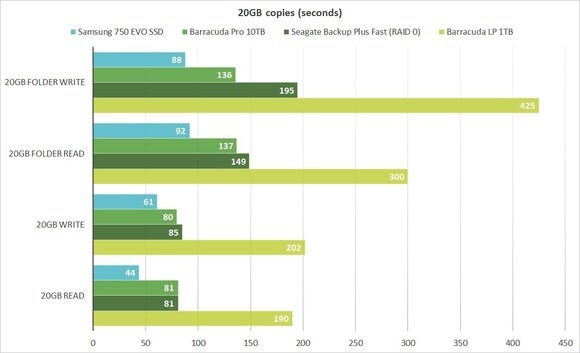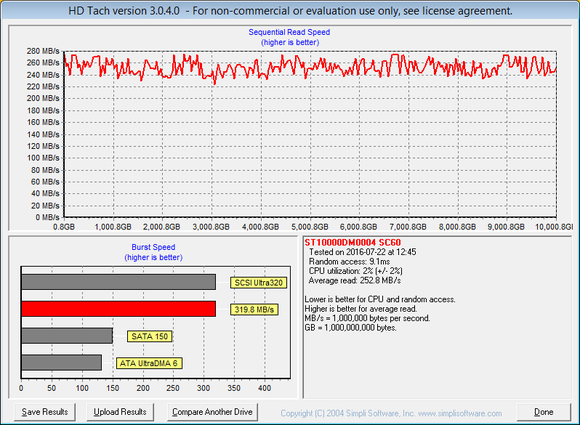
I’ve used “Vast and fast” to describe previous hard drives I’ve reviewed, but I’m not sure that it’s ever been this spectacularly well-deserved. Seagate’s 3.5-inch, 7,200rpm, SATA 6Gbps Barracuda Pro not only delivers a stunning 10TB of storage, it laid down some rather astounding transfer rates: 240MBps in both directions of our 20GB copy tests. At first, we didn’t quite believe what we were seeing, but several repeats and throwing even larger data sets at the drive convinced us.
The Barracuda Pro is still a hard drive, so seek times aren’t close to SSD-like, but if we had to build a system around a hard drive, this would be it.
Performance
By the numbers, AS SSD rated the drive at 243MBps reading and 229MBps writing. In our 20GB copy tests, which are subject to the vagaries of the Windows 8.1 operating system, that was closer to 250MBps each way with a single large file. Even with a 20GB mix of smaller files and folders, reads and writes, which were nearly identical in pace, dropped only to about 145MBps. (Ah, those seek times.)

How did Seagate do it? We’re not sure, but the CMR (conventional magnetic recording) drive is extremely high-density, and has a whopping 14 platters and 7 read-write heads. Perhaps the company has leveraged some of the algorithms developed over the last few years for SSD controllers and is scattering data equally about the platters. Combined with 7,200rpm and its 256MB cache, that could do the trick. Whatever Seagate’s done, we like it.
We also brought HD Tach out of retirement, and it seemed to say that the Barracuda Pro retains its speed across the entirety of its capacity. That’s unusual; hard drives tend to write faster on the outside of the platters where sectors whip by at a faster pace than on the inner portions of the disc. More fodder for speculation.

The Barracuda Pro also draws a mere (in HDD terms) 6.8 watts when operating. That’s very low for a hard drive, and far lower than, say, the five 2TB drives you’d need to get the same amount of capacity.
The ramifications of capacity
10TB is a lot of data. I have a hard time filling up my lone WD 4TB drive and there is a lot of multimedia on there. A lot. The Barracuda Pro is the equal of two of those, plus a 2TB drive. Unless you download a lot of stuff and never dump any of it, 10TB is massive overkill.
Not that you wouldn’t take a 10TB drive over a 4TB drive if they were handed out for free. But you do need to consider that you’re putting all your eggs in one basket. If the drive goes bad, still a very common occurrence, you’re SOL (surely outta luck). Unless, of course, you back up regularly, or are willing to pony up a substantial amount of coin for a pair of the $500 Barracuda Pros to mirror each other. Mirroring has saved my bacon many a time when backup schemes go wrong.

Seagate
All this adds up to a warning not to overbuy, especially if you’re already running an SSD, which you should be if you like fast data transfers. The Barracuda Pro’s speed is seductive, but a pair of 2TB drives (rather slow ones) can be had for $100 and a pair of average 4TB drives, around $250. That’s a lot more affordable. You can also mimic some of the performance (and increased vulnerability) of the Barracuda Pro by running two drives in RAID 0 (striped) rather than a mirrored RAID 1.
Warranty
The 10TB Barracuda Pro is warrantied for five years at 220TB worth of writes per year, or 1100TB over the warranted lifespan. The SSD folks call this TBW (terabytes written), and Seagate’s promise far outstrips the amount of data likely to be written to the drive. Then again, there are moving parts here. The warranty is limited, and includes only replacement, not data recovery. You’ll need to purchase Seagate’s Rescue service for that, at $10 for one year or $15 for two years. Why not the full five years? I can’t say, but most of my drives that have gone bad have lasted more than two years. Just saying.
Conclusion
This is an absolutely fantastic hard drive. But 10TB is massive overkill for the average consumer. And data redundancy in the form of a $1,000 mirrored RAID pair is very pricey.
Warnings aside. To heck with it—if the powers that be let me keep this drive, I’d replace my 4TB with it in a heartbeat. Keeping it routinely backed up, of course.
Note: This article was edited on 08/27/2016 to reflect different data provided by the vendor after publishing. CMR instead of SMR, and 220TB per year as opposed to 180TB.
source”gsmarena”